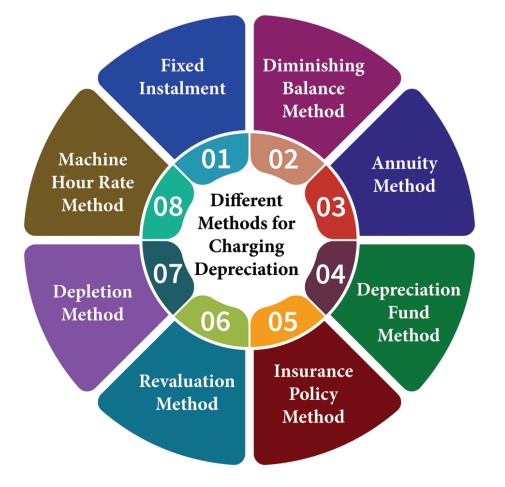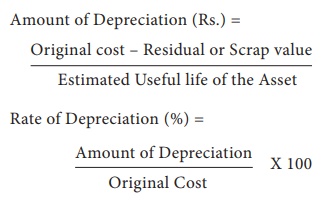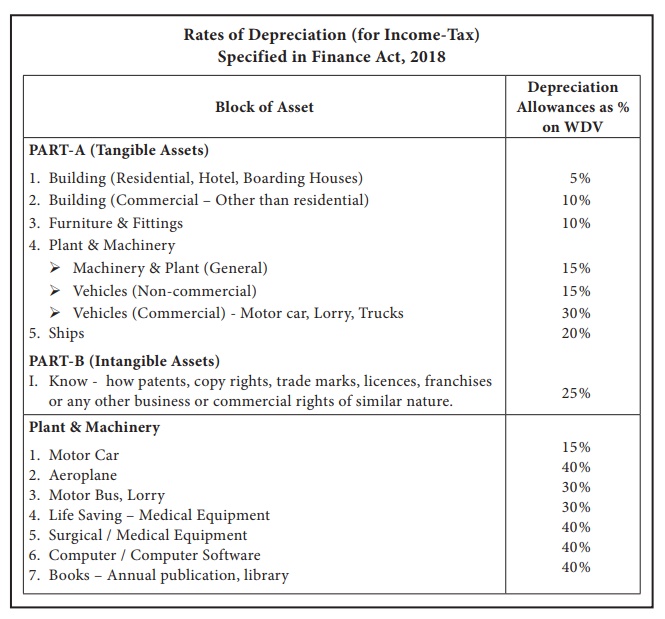Auditing - Different Methods of Charging Depreciation | 12th Auditing : Chapter 7 : Depreciation
Chapter: 12th Auditing : Chapter 7 : Depreciation
Different Methods of Charging Depreciation
Different Methods of Charging Depreciation

1. Straight Line (Or) Fixed Instalment Method
This is
the oldest and simplest method of charging depreciation. The life of the asset
is estimated and depreciation is written off equally over the life of an asset.
The amount of depreciation is such that the book value of the asset is reduced
to zero at the end of life of the asset. The amount of depreciation is
calculated as follows:
Amount
of Depreciation (Rs.) = Original cost – Residual or
Scrap value / Estimated Useful life of the Asset
Rate of
Depreciation (%) = [ Amount of Depreciation / Original Cost ] X 100

ADVANTAGES
1. Simple to Understand: This
method of calculating depreciation
is very simple to understand.
2. Easy to Calculate: It is
easy to calculate the amount and
rate of depreciation.
3. Accuracy: In this method, the book value of the asset, i.e., cost price
of the asset less depreciation, becomes zero or equal to its scrap value of the
expiry of its useful life.
DISADVANTAGES
1. Difficulty in Calculating Depreciation: Calculation
of depreciation is easy only when life of the original asset and its additions
are similar. When both have varied life calculation becomes difficult and
complicated.
2. No Provision for Replacement of Asset: This
method does not provide any
provision for replacement of asset on the expiry of its useful life.
3. This
method increases the charge to the Profit and Loss Account over the years
because the repairs to an old asset increases.
4. This
method increases the cost of the asset over the years as the amount of
depreciation is fixed over the years.
2. Diminishing or Written Down Value Method
In this
method depreciation is charged at a fixed percentage on the reducing balance of
the asset every year over the useful life of the asset. The amount of depreciation
goes on decreasing every year. This method is very useful for plant and
machinery where additions and extensions take place very often.
ADVANTAGES
1. It is
a simple method of providing depreciation as fixed rate is applied on book
value or written down value of assets.
2. This
method is quite popular.
3. It
provides uniform charge for services of the assets throughout the life.
DISADVANTAGES
1. The
method is slightly complicated.
2. If
the asset has no residual value it is very difficult to calculate the rate.
SUITABILITY
This
method of charging depreciation is suitable when – (a) the possibility of
obsolescence are more, and (b) the amount of repairs and renewals increases as
the asset grows older.
3. ANNUITY METHOD
Annuity
method considers both the value of asset and the amount of interest on the
investment made in the fixed asset. Besides, interest, a fixed amount of
depreciation is calculated on the basis of depreciation from Annuity Table and
is charged to Profit and Loss Account every year. The method is precise and
exact from the point of view of calculations, so it is called a scientific
method.
ADVANTAGES
1. This
method takes interest on capital invested in the asset into account.
2. It is
regarded as most exact and precise from the point of view of calculations and
is therefore most scientific.
DISADVANTAGES
1. The
system is complicated and difficult to understand.
2. The
ultimate consequences being that the net burden on profit and loss account
grows heavier each year.
4. DEPRECIATION FUND METHOD
This
method provides funds for the replacement of the asset at the end of its life.
The amount of depreciation is credited to an account called Sinking Fund or
Depreciation Fund account which is shown on the liabilities side of the balance
sheet. This amount is invested in securities.
Every
year the amount set aside for depreciation along with the interest is again
invested. The amount so invested is debited to an account known as Sinking Fund
Investment Account and these investments are shown as an asset in the Balance
Sheet. The amount of depreciation remains the same for the year.
The rate
of interest available from investments and the time required for replacement of
the assets enables determine the amount of depreciation. A reference to Sinking
Fund Table gives the extra amount of depreciation to be charged year after
year. The investments are sold when the asset is due for replacement and the
amount so received is used for purchasing the new asset.
The
value of asset is shown at its original cost in all years. In the last year,
the asset is written off by transferring it to Depreciation Fund Account.
This
method is suitable where intention is not to provide depreciation but also to
provide for its replacement as happens in case of Plant and Machinery and many
wasting assets.
ADVANTAGES
1. This
method sets aside certain amount for replacement of asset by maintaining
separate provision.
2. The
sale proceeds of the investments are useful for replacement of the asset.
3. This
method helps to strengthen financial position of a concern.
DISADVANTAGES
1. This method creates complication and burden on
funds each year as they are invested outside.
2. Prices
of securities may fall at the time when they are to be realized as a result of
which loss may have to be suffered.
5. INSURANCE POLICY METHOD
In this
method an insurance policy is purchased for the value of the asset. This policy
is taken up for the life of the asset and it matures at a time when the asset
is to be replaced. The amount provided for depreciation is paid towards
insurance premium. The amount of premium remains the same in all the years. On
maturity of the policy, insurance company will pay the amount and the amount
will be used for replacing the asset.
ADVANTAGES
1. Funds
are readily available for replacement of the asset.
2. Funds
are not used for other purposes as they are invested outside.
3. There
is no risk in getting back the money as the policy is taken with the insurance
company.
DISADVANTAGES
The
drawback of this method is that it creates an increasing burden on the funds of
each year as they are invested outside.
6. REVALUATION METHOD
In this
method the amount of depreciation is calculated by revaluing the asset at the
end of each year. The difference between the value of the asset at the
beginning and at the end of the period is taken as depreciation. There can be
an appreciation in value too. The amount of appreciation is debited to the
asset and credited to profit and loss account.
ADVANTAGES
·
It is easy to understand and simple to implement.
·
Depreciation is calculated every year in the
opening balance of asset.
·
This method equalizes the yearly burden on
profit and loss account in respect of depreciation.
DISADVANTAGES
·
This method charges heavy amount of
depreciation in earlier years.
·
It is difficult to assess the life of these
assets, calculation of depreciation becomes complicated.
·
The formula to obtain rate of depreciation can
be applied only when there is residual value of the asset.
·
This method has limited applicability.
7. DEPLETION METHOD
This
method is specially used for those assets which deplete with use. The cost of
the assets is divided by total workable deposits. The depreciation rate is
calculated by dividing the cost of the asset by the estimated quantity of
product likely to be available. Annual depreciation will be the quantity
extracted multiplied by the rate per unit.
For
example, If a mine has 2 lakh tons of coal and the value of mine is â‚ą 5 lakhs,
each ton of coal will cost â‚ą 2.50.
The
quantity of coal taken out of the mine in a period will be multiplied by the
rate per ton, i.e., â‚ą 2.50 and the resultant figure will be the amount of
depreciation.
ADVANTAGES
·
It provides a method to charge amortization or
depreciation for the companies dealing in resources, as these assets are
different in nature and consumption from other fixed assets like car, building
etc.
·
The method is easy to understand.
DISADVANTAGES
·
The method is simply used for a periodic
reduction in the cost of the asset.
·
The method is highly subjective especially the
number of units to be extracted is difficult to estimate.
8. MACHINE HOUR RATE METHOD
Under
this method, the life of a machine is estimated in terms of its working hours
instead of years. The total number of hours in which a particular machine will
work efficiently is estimated. The estimated number of hours is then divided by
the cost of the machinery less residual value to ascertain the hourly rate of
depreciation.
This
method is considered more scientific and precise than either the fixed installment
method or the reducing balance method.
ADVANTAGES
·
It helps to compare the relative efficiencies
and cost of operating different machines.
·
It is most scientific, practical and accurate
method of recovery of manufacturing overheads.
·
It provides ready method for measuring the cost
of idle machines.
DISADVANTAGES
·
It involves additional work in assessing the
working hours of machines and thus it is a costly method.
·
It gives inaccurate results if manual labour is
also used.

Related Topics